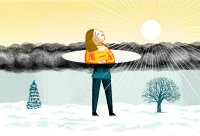How To Refine Your Teaching Practice With Springtime Reflection
Establishing a regular cycle of reflection allows new and experienced teachers alike to sharpen their practice.
Your content has been saved!
Go to My Saved Content.Spring is in the air. The weather is warming and days are getting longer. Spring signifies that the end of the academic school year is quickly approaching for most teachers. While many educators eagerly anticipate the end of another challenging year and look forward to getting some well-deserved rest, now is a good time to reflect on our experiences.
Reflective practice is an integral component of effective teaching because teaching is a process that we can improve with deliberation and scrutiny. Without reflection, teachers could be potentially trapped in a cycle of unexamined judgments, assumptions, and misinterpretations about their teaching. Further, research indicates that when teachers reflect on their practice, they develop their self-efficacy, which, according to psychologist Albert Bandura, is an individual’s belief in their capacity to execute behaviors necessary to produce specific performance attainments. Increased teacher self-efficacy has been shown to increase student achievement.
Reflecting Is a Process
Reflection is more than random ruminations about your teaching practice. According to research, reflection should be a cyclical process consisting of three components. First, teachers must identify a problem they want to address. Problem-solving means reflecting on situations that didn’t go well and then coming up with solutions to address the issue. Challenges could be student behavior, lessons that didn’t work as planned, or gaps in teacher professional or content knowledge.
Teachers could ask themselves the following questions to engage in the reflection process:
- What went well?
- What was difficult?
- What do I need to learn or do to further develop my craft?
- What have I learned about myself emotionally and as a practitioner?
- How can I improve my practice in the future?
Teachers can take notes of their reflections by writing them down in a teaching journal or using other methods to record their successes and utilize them in their planning for the following year, while determining action steps for the areas of teaching they need to work on to become better educators.
The second area of reflection is raising awareness about one’s own strengths and weaknesses as a professional educator. Teachers need to reflect often on what they’re doing well and areas they need to strengthen because as good as we may be, there’s always room for development. As Benjamin Franklin said, “Without continual growth and progress, such words as improvement, achievement, and success have no meaning.”
Reflection allows teachers to develop and refine their practice rather than doing things the way they’ve always done them. This is important for new and experienced teachers alike. When teachers engage in reflection, they can celebrate their strengths by acknowledging what they’re doing well. But teachers also need to recognize areas they need to work on. An excellent way to do this is to use the Johari window.
The Johari window is a technique designed to help individuals understand their relationships with themselves and others. One of the method’s strengths is that it may illuminate blind spots or areas that are not known to an individual but are things other people and students can see. The blind spot could be a barrier to self-awareness, which is essential for effective teaching. Further, teachers need to stay positively motivated despite the myriad challenges they face, especially over the last few years of the pandemic.
While negative emotions are perfectly normal, it’s essential that teachers keep them in check because they can’t teach to their full potential if they’re in a negative headspace. Flight attendants warn passengers to take care of their needs first before trying to help others. The same goes for teachers. We can’t be fully present for our students unless our needs are adequately met first. This is why self-care is critical, especially during these challenging times.
The last component of reflective practice is constructing professional knowledge through both formal and informal teaching networks. Professional knowledge consists of an in-depth understanding of subject matter, curriculum, instruction, assessment, and knowledge of students and their communities to raise student achievement. Teachers need to build professional communities of practice so that they can collaborate and learn with other practitioners. Partnerships between experienced educators and those new to the profession, or those needing assistance, are a fundamental component of teacher professionalism and growth.
Formal networks can include mentorships, professional learning communities (PLC), and membership in various professional education organizations as they relate to the teaching field or discipline. Informal teaching networks could consist of participation in professional learning networks (PLN), following and posting to social media hashtags, and developing informal professional relationships, both in person and virtually, within your school and district, and across the state, nation, and world.
